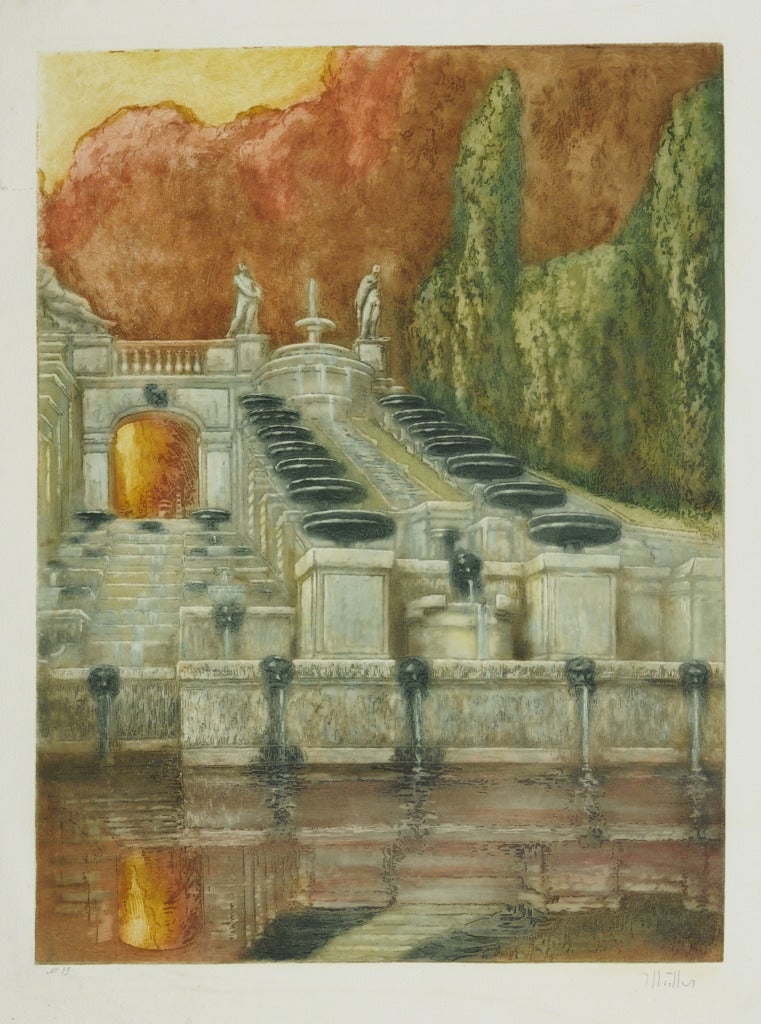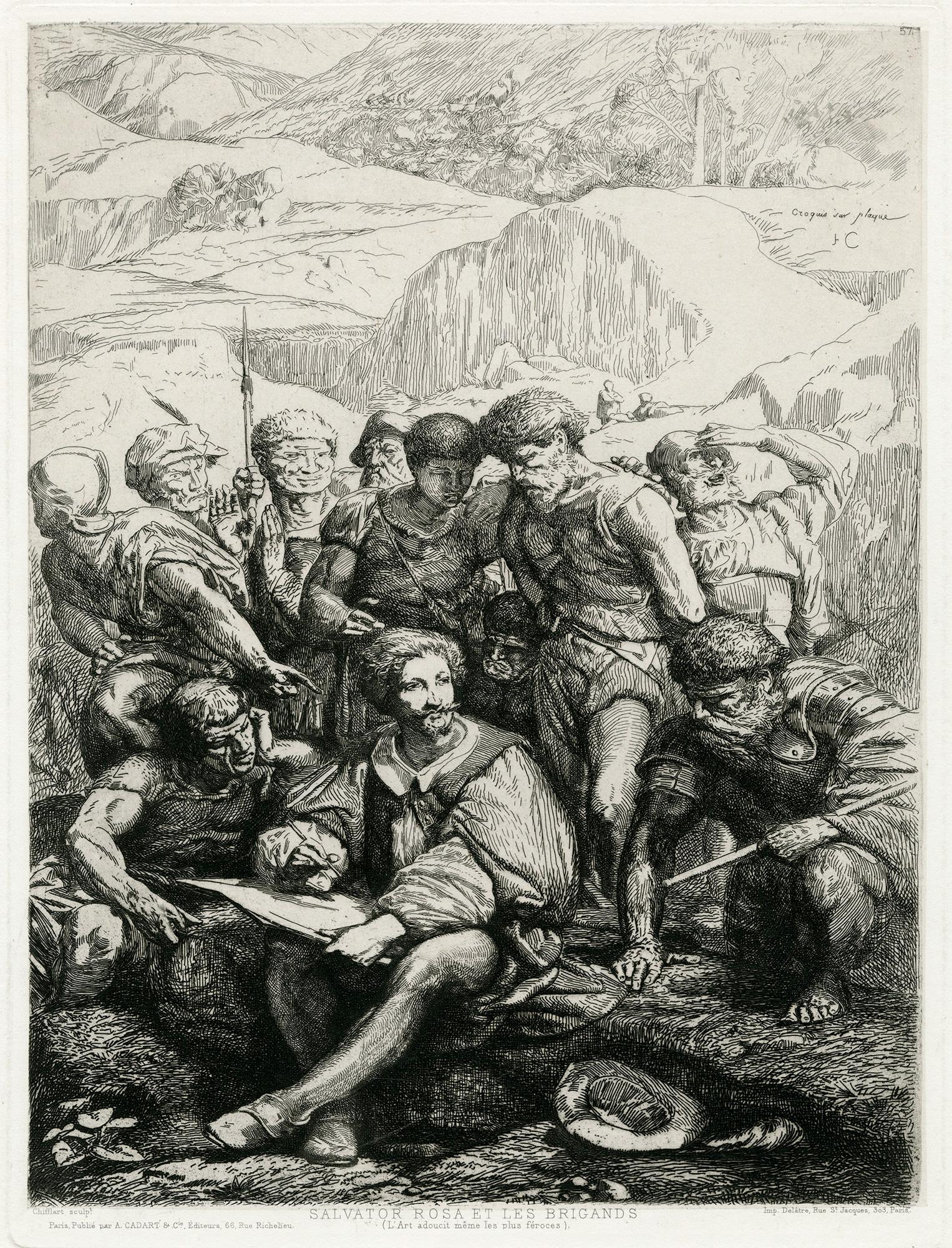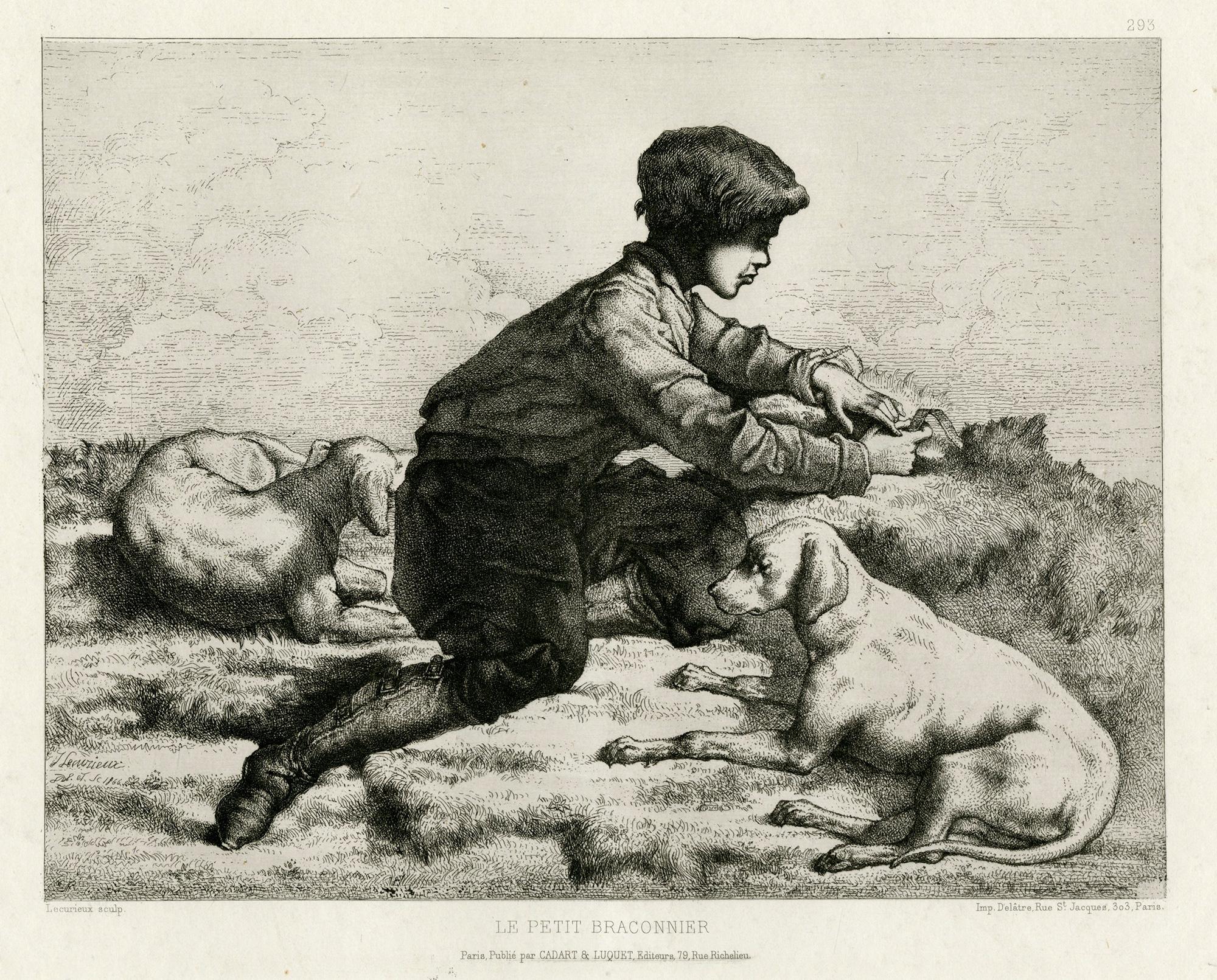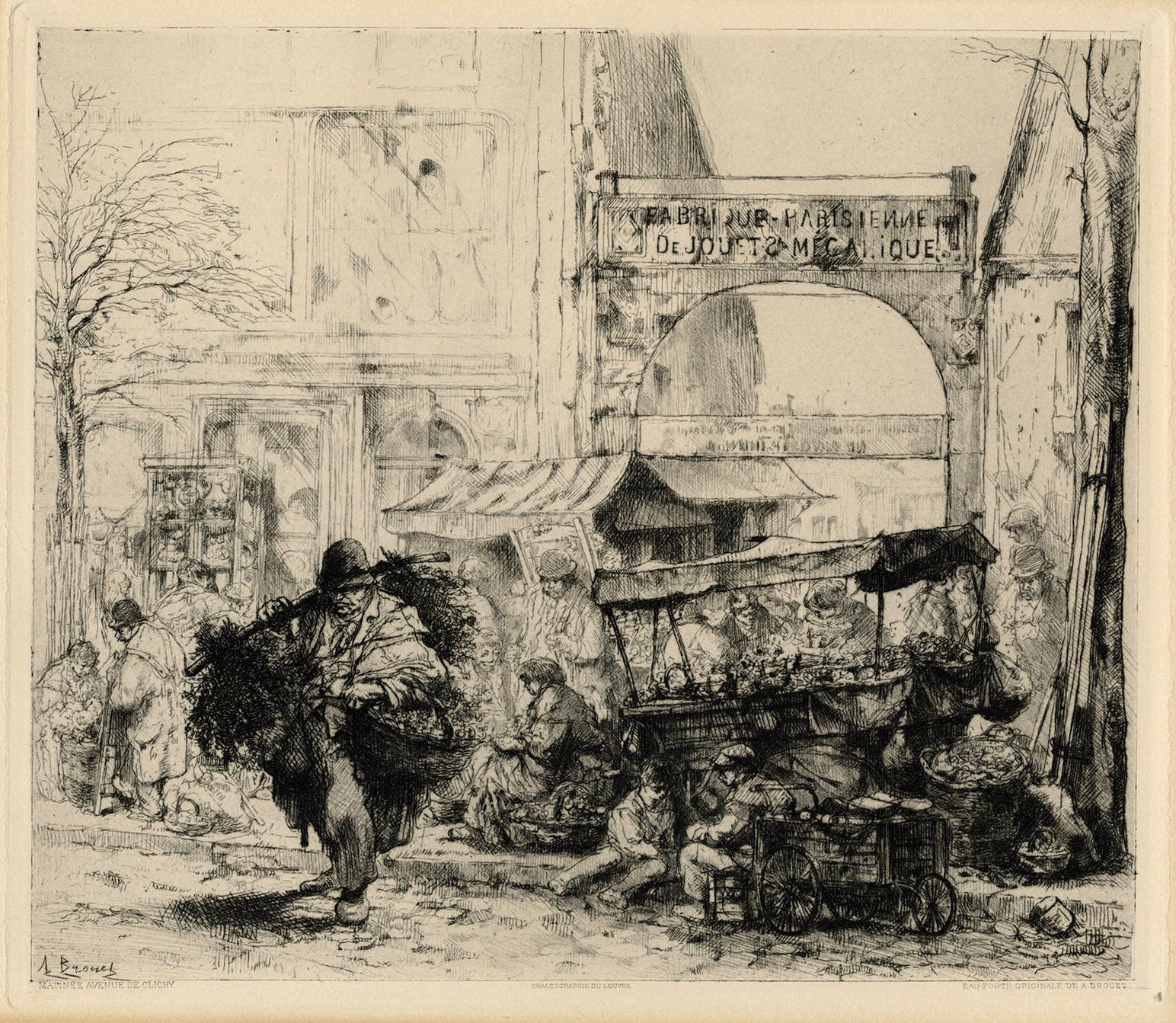Items Similar to L’Angelus (The Bell Tower)
Want more images or videos?
Request additional images or videos from the seller
1 of 6
Félix Hilaire BuhotL’Angelus (The Bell Tower)c. 1876
c. 1876
About the Item
L’Angelus (The Bell Tower)
etching & drypoint, c. 1876
Signed in the plate with the artist's initials (see photo)
Condition: Excellent
Image/Plate size: 5 7/8 x 4 1/4 inches
Sheet size: 7 3/8 x 5 1/2 inches
Reference: Bourcard/Goodfriend 72 iii/IV, final state before cancelation of the plate
This image is the artist’s homage to Corot.
Félix-Hilaire Buhot
French, 1847 - 1898
Among the most original prints made in France during the last quarter of the nineteenth century are those by Félix Buhot. Born in 1847 in the small Normandy town of Valognes, in northern France, Buhot moved to Paris in 1865, where a year later he enrolled in the École des Beaux-Arts, studying painting and drawing under various artists. Buhot first learned to etch in about 1873, producing his first etching later that year and quickly establishing himself as a successful printmaker. The young artist made his living by decorating fans and illustrating lithographic sheet music. Buhot lived and worked most of his life in Paris, with frequent visits back to northern France and extended trips to England where he met his wife, Henrietta Johnston, whom he married in 1881. By 1892 Buhot had ceased making prints, and in 1898, after suffering prolonged bouts of deep depression, he died at the age of fifty-one.
Along with Edgar Degas and Camille Pissarro, Félix Buhot numbers among the most experimental printmakers of his day. In exploring the unique aspects of etching, he developed an approach to printmaking that was very painterly; in fact he called his prints "paintings on copper." A true printmaker's printmaker, Buhot delighted in all the technical variables and regularly combined multiple processes to produce a single print: he achieved even greater tonal variation by employing the more traditional techniques of etching, drypoint, and aquatint along with several less familiar methods. Unlike many contemporary printmakers who disliked photography, Buhot heartily embraced the medium and used it as a creative aid. He also used different inks and papers for varied effects. His most original contribution to the history of printmaking is a device he termed marges symphoniques (symphonic margins): by amplifying the main subject, such illustrations became an integral part of the print.
In his many prints of city views and seascapes, Buhot was intent on creating a specific atmosphere, especially the effects of weather such as rain, snow, mist, and fog. He turned to his immediate neighborhood in and around the boulevard de Clichy in Montmartre, Paris, for inspiration for his prints of everyday city life. Buhot delighted in portraying the varied street life of the vibrant capital city not only in different seasons (Winter in Paris, 1879) but also in moments of public display, from a festive holiday celebration (National Holiday on the Boulevard de Clichy, 1878) to a somber death observance (Funeral Procession on the Boulevard de Clichy, 1887). His city views also include London scenes (Westminster Palace and Westminster Bridge, both of 1884). And Buhot's love for the sea is evidenced in the many prints exploring its ever-changing atmospheric conditions and moods. Buhot's boat trips to England inspired two of his most characteristic prints, A Pier in England and Landing in England, both from 1879.
With his experimental printmaking techniques, Buhot became one of the best-known, admired, and collected printmakers of his day. He achieved success for his prints at the annual Salons between 1875 and 1886, and a number of his works were published in leading periodicals and books. He also found critical acclaim and support for his prints in the United States, especially after his first one-man exhibition organized by the New York print dealer Frederick Keppel in 1888.
Courtesy: National Gallery of Art, Washington, D. C.
- Creator:Félix Hilaire Buhot (1847 - 1898, French)
- Creation Year:c. 1876
- Dimensions:Height: 5.88 in (14.94 cm)Width: 4.25 in (10.8 cm)
- Medium:
- Movement & Style:
- Period:
- Condition:
- Gallery Location:Fairlawn, OH
- Reference Number:
About the Seller
5.0
Recognized Seller
These prestigious sellers are industry leaders and represent the highest echelon for item quality and design.
Platinum Seller
These expertly vetted sellers are 1stDibs' most experienced sellers and are rated highest by our customers.
Established in 1978
1stDibs seller since 2013
711 sales on 1stDibs
Typical response time: 1 hour
Associations
International Fine Print Dealers Association
- ShippingRetrieving quote...Ships From: Akron, OH
- Return PolicyA return for this item may be initiated within 10 days of delivery.
More From This SellerView All
- La Grande Cascade de Saint CloudBy Alfredo MüllerLocated in Fairlawn, OHLa Grande Cascade de Saint Cloud Color aquatint on watermarked Arches J Perrigot paper, 1905 Signed by the artist in pencil lower right. (see photo) Edition: 100. Numbered "39" in pencil lower left. Titled in pencil verso Published by Edmund Sagot, Paris, his dry stamp lower right below signature. Image: 23-1/8 x 17-3/8" (58.7 x 44 cm.) From the British Museum: "Colour etcher. Born in Livorno from a family of wealthy Swiss cotton merchants, studied with Giuseppe Ciaranfi and Michele Gordigiani in Florence. In 1886 exhibited with Fattori, Achille Lega and Tommasi in the Prima Esposizione delle Belle Arti in Livorno. In 1888 he and his family moved to Paris, where he studied first with François Flameng until 1892 and later with Carolus-Duran. Müller remained in the French capital until the outbreak of the First World War, taking French citizenship in 1913. He worked in the countryside at Barbizon, Suresnes and elsewhere, but also made frequent visits to his native country, where he exhibited regularly in Florence with the Promotrice Fiorentine. His early work was indebted to Fattori and Plinio Nomellini, but he soon became interested in the Impressionists and was credited by the critic Mario Tinti with introducing the luminism of Monet into Italian art. Müller was a member of the Société des Artistes Indépendents and exhibited regularly in the Paris dealer George Petit's annual exhibitions of colour prints. He made his first print in 1896, a lithographic portrait of the poet Paul Verlaine in the Café Procope. The following year Müller made his first colour aquatints. Among them were a series of illustrations to Dante's Divine Comedy. In style his etchings and aquatints were influenced by Manuel Robbe. Very occasionally he combined drypoint or soft ground etching with aquatint. Müller's principal publisher was Pierrefort, who also issued prints by Toulouse-Lautrec. After 1903 he largely abandoned aquatint for pure etching. Fourteen of his colour etchings were reproduced over a number of months in the weekly magazine 'Le Courrier français'. Müller also made a small number of colour lithographs, some of which were published by the Parisian print dealer Sagot. A single monotype of Mallarmé done in 1911, thirteen years after the poet's death in 1898, is recorded. Müller made a few landscape prints and a couple of etchings of fishing boats, but his principal subject was young women in long dresses. Often there is an aura of fin-de-siècle wistfulness. When he returned to Italy, he lived first in Taormina, then in Florence, and finally settled in a villa at Settignano. Müller largely abandoned printmaking after 1914. Only three more prints by him made in 1920, 1925 and 1933 are recorded after he moved back to his native country. Müller was a regular exhibitor in Florentine exhibitions, the most significant of which was the 1922 Primaverile Fiorentina. He returned to France in 1930 where he died in 1939. (Text by Martin Hopkinson)" Said to rival the fountains at Versailles, La Grande Cascade is still turned on for a few hours every Sunday in June. The Grande Cascade, constructed in 1664-1665 by Antoine Le Pautre has survived. The château was expanded by Phillipe de France, duc d'Orléans in the 17th century, and finally enlarged by Marie Antoinette in the 1780s. Napoleon I and Napoleon III also used the palace, which was a U-shaped scheme of three sections, open to the east. Destroyed by fire (with the exception of a few outbuildings and its majestic garden) in 1870, during the Franco-Prussian War. The burned-out shell stood until 1891, when it was demolished. The gardens were replanned by André Le Nôtre...Category
Early 1900s French School Prints and Multiples
MaterialsAquatint
- Westminster PalaceBy Félix Hilaire BuhotLocated in Fairlawn, OHWestminster Palace Etching, Drypoint, Aquatint, roulette and salt ground lift 1884 Depicts the Houses of Parliament, Big Ben Clock and Tower and the River Thames in the foreground. S...Category
1880s French School Landscape Prints
MaterialsEtching
- untitled (Fishing Boats, Normandy)By Kamesuke HiragaLocated in Fairlawn, OHuntitled (Fishing Boats, Normandy) Soft Ground Etching, 1930 Signed and dated in pencil by the artist Sealed by the artist Annotated "Paris" Possibly a view of a fishing port in Norm...Category
1930s French School Landscape Prints
MaterialsEtching
- Dejeuner sur l'HerbeBy After Paul CezanneLocated in Fairlawn, OHDejeuner sur l'Herbe Lithograph, c. 1914 Edition: c. 100 Unsigned as issued by Vollard References And Exhibitions: Commissioned from Cezanne by Ambrose Vollard in the late 1890s Prin...Category
1910s French School Landscape Prints
MaterialsLithograph
- Night Life at the Moulin RougeBy Henry SommLocated in Fairlawn, OHNight Life at the Moulin Rouge Pen and ink drawing, c. 1890 Signed lower left (see photo) A scene of the night life near the Moulin Rouge, Paris. The Moulin Rouge is the famous cabaret located in the old wind mill building in the right distance of this image. It was the center of fin de siecle culture in Paris. Condition: Slight yellowing to the sheet from age. Sight size: 9 x 5 3/4 inches Frame size: 14-1/8 x 10-3/4 x 1/2" Provenance: Eric G. Carlson (1940-2016), art historian and noted art dealer François Clément Sommier, best known under the pseudonym “Henry Somm,” was born in Rouen in 1844. He attended the local École municipale des beaux-arts and went on in 1867 to Paris, where he studied under Isidore Pils (1813-1875). “Somm is above all a painter and his watercolors are much sought after; he has the painter’s eye to the highest degree imaginable.” Louis Morin, Somm’s fellow artist revealed in 1893 that while his training as an academic painter forged his draughsmanship and an acute eye for colors, Somm preferred and excelled in the graphic realm. Particularly prolific, he produced a very extensive corpus of 7,500 drawings and prints, many of which were widely reproduced in journals and magazines. In 1867, Somm’s career reached a turning point with the discovery of Japanese culture through his friendship with French collector and critic Philippe Burty and a visit to the Paris International Exhibition. More generally, Japanese art and especially Japanese woodblock prints exerted a heavy influence on French artists at the time, and especially on the Impressionists, who were particularly inspired by the subject matter, as well as the innovative use of perspective, composition and color. Although technically not an Impressionist by pure definition, Somm’s interest in the effect of atmospheric light on shadow and color prompted Edgar Degas to invite him to participate in their 4th exhibition in 1879. However, Somm did not exhibit again with the Impressionists, and was never considered a member of the group. Rather, his work intersects between Impressionism, Symbolism and Japonism. In fact, while his drypoints and etchings reflect a more literal borrowing of Japanese elements than the work of Whistler or Monet, they also clearly anticipate the future work of Henri de Toulouse-Lautrec. Although Somm was 20 years older than Toulouse-Lautrec, both artists developed a friendship, as habitués of the Chat noir, a cabaret founded by Rodolphe Salis and located 84 boulevard de Rochechouart in Montmartre. More than a cabaret, the Chat noir also became an important gathering place for writers, poets, composers, musicians, and artists living in Montmartre. For Somm, a founding member of this artistic circle, it also served as a unique environment, where he could express his limitless imagination as active participant to the events – notably the literary soirées organized by the hydropathic group – and illustrator of the Chat noir journal. In 1886, Somm, in collaboration with Georges Auriol, initiated the Chat noir’s first puppet show, which subsequently evolved into shadow theater. Somm’s Japonism and sense of humor appealed to Toulouse-Lautrec, and this influence is echoed in Lautrec posters advertising two other Montmartre nightspots, namely Le Mirliton and Le Divan Japonais...Category
Late 19th Century French School Drawings and Watercolor Paintings
MaterialsInk
- Barges, DordrechtBy James Abbott McNeill WhistlerLocated in Fairlawn, OHBarges, Dordrecht Etching, c. 1886 Signed in the plate with the butterfly Edition: One of 10 known impressions of this image. VERY RARE Provenance: Frederick Keppel & Co. with their ...Category
19th Century Impressionist Landscape Prints
MaterialsEtching
You May Also Like
- Salvator Rosa et les Brigands; ..L'Art adoucit même les plus férocesLocated in Middletown, NY"Art softens even the most ferocious." Paris: Cadart & Luquet, 1865. Etching and engraving on Chine-collé mounted to watermarked Aqua-Fortistes cream laid paper, 12 1/2 x 9 1/2 inc...Category
Mid-19th Century French School Landscape Prints
MaterialsEngraving, Handmade Paper, Etching
- Le MatinLocated in Middletown, NYParis: Cadart & Luquet, 1865 Etching and engraving on Chine-collé mounted to watermarked Aqua-Fortistes cream laid paper, 9 5/8 x 12 3/4 inches (243 x 322 mm), full margins with thr...Category
Mid-19th Century French School Landscape Prints
MaterialsEngraving, Etching, Handmade Paper
- Le Petit BraconnierLocated in Middletown, NYA boy kneels on a grass slope, trying to tempt an unseen animal. Paris: Cadart & Luquet, 1865 Etching and engraving on Chine-collé mounted to watermarked Aqua-Fortistes cream laid ...Category
Mid-19th Century French School Landscape Prints
MaterialsEngraving, Handmade Paper, Etching
- Matinée Avenue de ClichyBy Auguste BrouetLocated in Middletown, NYDrypoint etching on buff wove paper, 9 1/2 x 10 3/4 inches (240 x 271 mm) full margins. Signed in the image, lower left. With the "Musée Louvre Chalcographie" blind stamp in the lowe...Category
Early 20th Century French School Landscape Prints
MaterialsHandmade Paper, Drypoint, Etching
- En Provence; la Maison d'Orléans (Valognes)By Félix Hilaire BuhotLocated in Middletown, NYEtching in brownish black ink on cream laid paper, 5 3/8 x 3 1/2 inches (135 x 87 mm), partially trimmed lower sheet edge. With the artist's moniker in ...Category
1840s French School Landscape Prints
MaterialsHandmade Paper, Etching
- Don Quixote ReadingBy Jean-Honoré FragonardLocated in Middletown, NYEtching on a large sheet of light cream wove paper, Baron Dominique Vivant Denon (after Jean-Honoré Fragonard); Paris: c 1900; 4 3/4 x 3 1/2 inches (120 x 90 mm), full margins. In go...Category
Early 20th Century French School Figurative Prints
MaterialsEtching, Handmade Paper





